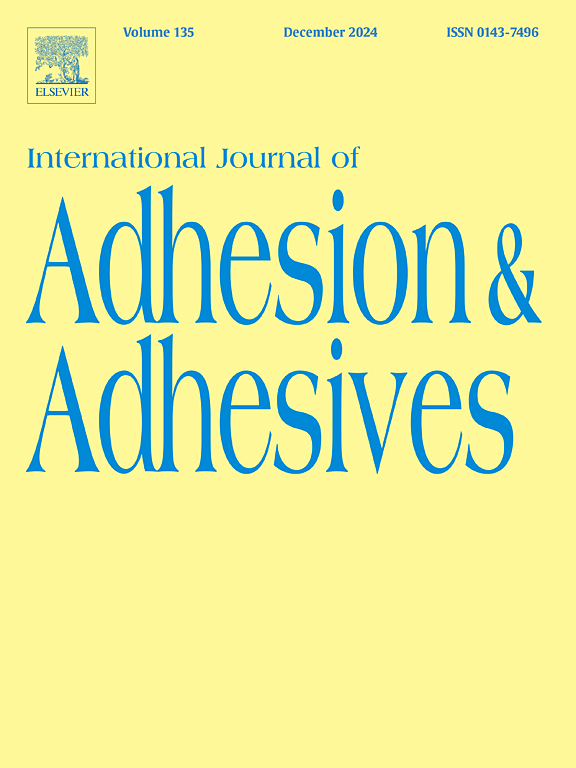经乙二醛和氯化锌改性的生物基大麻蛋白胶粘剂的研制
IF 3.5
3区 材料科学
Q2 ENGINEERING, CHEMICAL
International Journal of Adhesion and Adhesives
Pub Date : 2025-09-24
DOI:10.1016/j.ijadhadh.2025.104165
引用次数: 0
摘要
目前,甲醛基粘合剂在全球市场占据主导地位,占粘合剂总使用量的70%以上。然而,这些合成胶粘剂造成了严重的健康问题和环境问题。因此,本研究探索大麻籽蛋白作为一种可行的替代品,用于制造适合胶合板应用的生物基粘合剂。将大麻籽面粉脱脂并加工以提取蛋白质。通过调节pH值和控制混合,制备了蛋白质浓度为15%的黏合剂浆料。该研究使用化学改性剂,如乙二醛和氯化锌(ZnCl2),单独或组合,以提高粘合剂的强度,热稳定性和耐水性。对樱桃木单板的粘附试验表明,所有改性剂,特别是乙二醛,都能显著提高樱桃木单板的干、湿、浸强度,最大值分别为5.69 MPa、2.68 MPa和4.91 MPa。ZnCl2通过离子交联提高了性能,强度和稳定性得到了适度的提高。然而,联合处理在共价交联和离子交联机制之间的协同作用有限。当起始温度和变性温度分别升高到146.34℃和147.74℃时,乙二醛显著提高了热稳定性。扫描电镜显示,乙二醛产生了更致密、更紧凑的粘合网络,而ZnCl2则导致了更温和的结构改善。这些发现证明了乙二醛修饰的大麻籽蛋白粘合剂在工程木材应用中的潜力,为可持续技术提供了一条有前途的途径。此外,ZnCl2允许灵活的配方,提高这些生物基粘合剂的整体效用。本文章由计算机程序翻译,如有差异,请以英文原文为准。

Development of bio-based hempseed protein adhesives with enhanced properties and performance via glyoxal and zinc chloride modification
Formaldehyde-based adhesives currently dominate the global market, representing over 70 % of the total adhesive usage. However, these synthetic adhesives pose significant health concerns and environmental concerns. In response, this study explores hempseed protein as a viable alternative for creating bio-based adhesives suitable for plywood applications. Hempseed flour was defatted and processed to extract proteins. Adhesive slurries were prepared with 15 % protein concentration through pH adjustment and controlled mixing. The study employed chemical modifiers such as glyoxal and zinc chloride (ZnCl2), both individually and in combination, to enhance the adhesive's strength, thermal stability, and water resistance. Adhesion tests on cherry wood veneers revealed that all modifiers, particularly glyoxal, significantly improved the dry, wet, and soaked strength, achieving maximum values of 5.69 MPa, 2.68 MPa, and 4.91 MPa, respectively. ZnCl2 contributed to performance enhancements through ionic crosslinking, yielding moderate improvements in strength and stability. However, combined treatments showed limited synergy effects between covalent and ionic crosslinking mechanisms. Glyoxal notably enhanced thermal stability with onset and denaturation temperatures increasing to 146.34 °C and 147.74 °C, respectively. SEM revealed that glyoxal produced denser, more compact adhesive networks, whereas ZnCl2 led to more moderate structural improvements. These findings demonstrated the potential of glyoxal-modified hempseed protein adhesives for engineered wood applications, offering a promising avenue toward sustainable technologies. Furthermore, ZnCl2 allows for flexible formulations, enhancing the overall utility of these bio-based adhesives.
求助全文
通过发布文献求助,成功后即可免费获取论文全文。
去求助
来源期刊

International Journal of Adhesion and Adhesives
工程技术-材料科学:综合
CiteScore
6.90
自引率
8.80%
发文量
200
审稿时长
8.3 months
期刊介绍:
The International Journal of Adhesion and Adhesives draws together the many aspects of the science and technology of adhesive materials, from fundamental research and development work to industrial applications. Subject areas covered include: interfacial interactions, surface chemistry, methods of testing, accumulation of test data on physical and mechanical properties, environmental effects, new adhesive materials, sealants, design of bonded joints, and manufacturing technology.
 求助内容:
求助内容: 应助结果提醒方式:
应助结果提醒方式:


